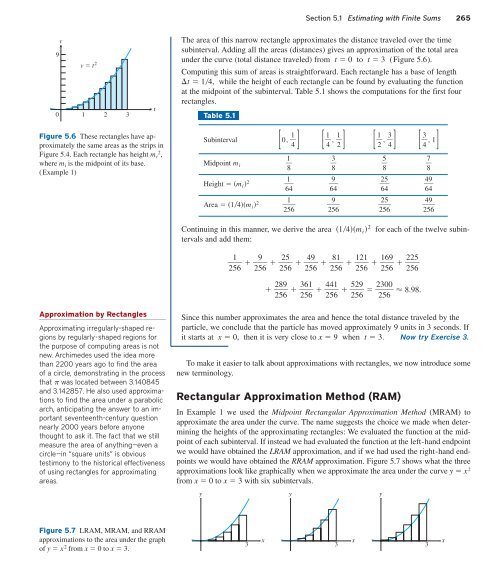FDWK_3ed_Ch05_pp262-319
FDWK_3ed_Ch05_pp262-319
FDWK_3ed_Ch05_pp262-319
You also want an ePaper? Increase the reach of your titles
YUMPU automatically turns print PDFs into web optimized ePapers that Google loves.
Section 5.1 Estimating with Finite Sums 265<br />
9<br />
v<br />
v t 2<br />
0 1 2 3<br />
Figure 5.6 These rectangles have approximately<br />
the same areas as the strips in<br />
Figure 5.4. Each rectangle has height m i 2 ,<br />
where m i is the midpoint of its base.<br />
(Example 1)<br />
t<br />
The area of this narrow rectangle approximates the distance traveled over the time<br />
subinterval. Adding all the areas (distances) gives an approximation of the total area<br />
under the curve (total distance traveled) from t 0 to t 3 (Figure 5.6).<br />
Computing this sum of areas is straightforward. Each rectangle has a base of length<br />
Dt 14, while the height of each rectangle can be found by evaluating the function<br />
at the midpoint of the subinterval. Table 5.1 shows the computations for the first four<br />
rectangles.<br />
Table 5.1<br />
Subinterval<br />
[ 0, 1 4 ] [ 1 4 , 1 2 ] [ 1 2 , 3 4 ] [ 3 4 ,1 ]<br />
Midpoint m i 1 8 3 8 5 8 7 8 <br />
Height m i 2 1<br />
9<br />
6 4<br />
6 4 2 5<br />
64 4 9<br />
64 <br />
Area 14m i 2 1<br />
2 56 9<br />
256 25<br />
49<br />
<br />
256<br />
2 56<br />
for each of the twelve subin-<br />
Continuing in this manner, we derive the area 14m i 2<br />
tervals and add them:<br />
1<br />
2 56 9<br />
256 25<br />
49<br />
81<br />
1 21<br />
1 69<br />
2 2<br />
<br />
5<br />
256<br />
2 56<br />
2 56<br />
256<br />
256<br />
256<br />
2 89<br />
3 61<br />
4 41<br />
5 29<br />
2 300<br />
8.98.<br />
256<br />
256<br />
256<br />
256<br />
256<br />
Approximation by Rectangles<br />
Approximating irregularly-shaped regions<br />
by regularly-shaped regions for<br />
the purpose of computing areas is not<br />
new. Archimedes used the idea more<br />
than 2200 years ago to find the area<br />
of a circle, demonstrating in the process<br />
that was located between 3.140845<br />
and 3.142857. He also used approximations<br />
to find the area under a parabolic<br />
arch, anticipating the answer to an important<br />
seventeenth-century question<br />
nearly 2000 years before anyone<br />
thought to ask it. The fact that we still<br />
measure the area of anything—even a<br />
circle—in “square units” is obvious<br />
testimony to the historical effectiveness<br />
of using rectangles for approximating<br />
areas.<br />
Since this number approximates the area and hence the total distance traveled by the<br />
particle, we conclude that the particle has moved approximately 9 units in 3 seconds. If<br />
it starts at x 0, then it is very close to x 9 when t 3. Now try Exercise 3.<br />
To make it easier to talk about approximations with rectangles, we now introduce some<br />
new terminology.<br />
Rectangular Approximation Method (RAM)<br />
In Example 1 we used the Midpoint Rectangular Approximation Method (MRAM) to<br />
approximate the area under the curve. The name suggests the choice we made when determining<br />
the heights of the approximating rectangles: We evaluated the function at the midpoint<br />
of each subinterval. If instead we had evaluated the function at the left-hand endpoint<br />
we would have obtained the LRAM approximation, and if we had used the right-hand endpoints<br />
we would have obtained the RRAM approximation. Figure 5.7 shows what the three<br />
approximations look like graphically when we approximate the area under the curve y x 2<br />
from x 0 to x 3 with six subintervals.<br />
y<br />
y<br />
y<br />
Figure 5.7 LRAM, MRAM, and RRAM<br />
approximations to the area under the graph<br />
of y x 2 from x 0 to x 3.<br />
3<br />
x<br />
3<br />
x<br />
3<br />
x


